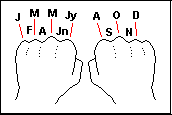°
°
DAYS IN EACH MONTH
The number of days in each month has remained unchanged for 2000 years (since 45 B.C. in fact, when Julius Caesar introduced the Julian Calendar). Here's a well-known mnemonic rhyme which has been in existence for over 400 years, to indicate the exact number of days in each different month:
30 days hath September,
April, June and November,
All the rest have 31,
Excepting February alone
(And that has 28 days clear,
With 29 in each leap year).
The number of days in each month can also be found by counting across the knuckles and valleys on the back of each clenched fist (from left to right):

Each "knuckle" month has 31 days, while each "valley" month has only 30 days (excepting of course February).
February has a smaller "leftover" amount of 28 or 29 days because pre-45 B.C. it was the last month of the Roman calendar year which started every March.
Each month-name originated from the Roman calendar, and mostly from the pre-Julian (or "Nunian") calendar where September was Septilis (Latin for 'seventh month') and is still the seventh month counting from March. Similarly October, November and December mean 'eighth, ninth, and tenth month'. The fifth month was Quinctilis until it was renamed Julius (hence July) in honour of Julius Caesar, whereupon his successor the emperor Augustus renamed Sextilis after himself too (hence August). Augustus also added a day to August (making 31) so as match that for Julius!
The remaining months are either named after Roman gods (Janus, Mars, Maia, Juno) or have a religious significance (Februarius meaning purification month' before the new year cycle, and Aprilis being connected to well-being and prosperity).
A separate page has mnemonics concerning the origin of day names and their equivalent in other languages.